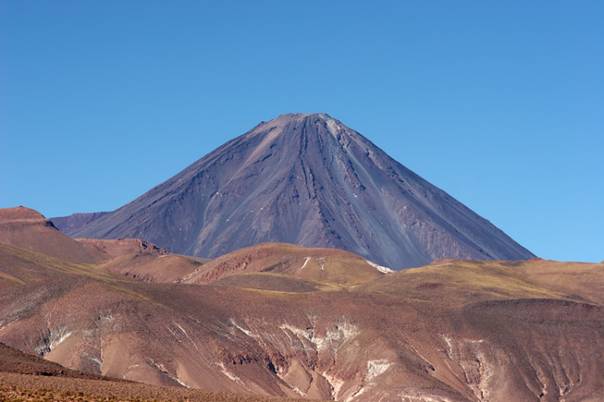Record Levels Of Solar Ultraviolet On Earth's Surface Hit South America
By Countercurrents
09 July, 2014
Countercurrents.org

Licancabur volcano. Credit: © Alexander Zotov / Fotolia
The Bolivian Andes has been hit by record levels of ultraviolet radiation. It is only 1,500 miles from the equator. The observed level was considered to be harmful to life.
A team of researchers from the US and Germany has measured the highest level of ultraviolet radiation ever recorded on earth's surface. The extraordinary UV fluxes, observed in the Bolivian Andes, are far above those normally considered to be harmful to both terrestrial and aquatic life.
The results are being published in the open-access journal Frontiers in Environmental Science .
The scientists made the measurements in the southern hemisphere summer of 2003 and 2004, using instruments developed for the European Light Dosimeter Network (Eldonet). The measurements were undertaken as a team led by Nathalie A. Cabrol of the SETI Institute and NASA Ames Research Center was investigating high altitude Andean lakes as part of an astrobiology study of Mars-like environments.
Dosimeters were deployed on the summit of the towering Licancabur volcano (altitude: 5,917 meters) and at nearby Laguna Blanca (altitude 4,340 meters). The combination of a midday sun near the zenith as well as the high elevation of these sites produces higher irradiance levels because of naturally low ozone in such locations. But these intensities of short-wavelength UV-B radiation (280 -- 315 nm) are unprecedented.
"These record-setting levels were not measured in Antarctica , where ozone holes have been a recurring problem for decades," says Cabrol. "This is in the tropics, in an area where there are small towns and villages."
"A UV index of 11 is considered extreme, and has reached up to 26 in nearby locations in recent years," notes Cabrol. "But on December 29, 2003, we measured an index of 43. If you're at a beach in the US , you might experience an index of 8 or 9 during the summer, intense enough to warrant protection. You simply do not want to be outside when the index reaches 30 or 40."
The intense radiation coincided with other circumstances that may have increased the UV flux including ozone depletion by increased aerosols from both seasonal storms and fires in the area. In addition, a large solar flare occurred just two weeks before the highest UV fluxes were registered. Ultraviolet spikes continued to occur -- albeit at lower intensity -- throughout the period of solar instability, and stopped thereafter. While the evidence linking the solar event to the record-breaking radiation is only circumstantial, particles from such flares are known to affect atmospheric chemistry and may have increased ozone depletion.
"While these events are not directly tied to climate change, they are sentinels of what could occur if ozone thins globally," Cabrol says. "The thinner and more unstable the ozone, the more prone we will be to this kind of event."
High UV-B exposure negatively affects the entire biosphere, not just humans. It damages DNA, affects photosynthesis, and decreases the viability of eggs and larvae. For these reasons, it is important to keep a close watch on UV flux levels.
"While this unsettling record might be the result of a 'perfect storm' of events, it could happen again," says Cabrol, "because the factors that caused it are not rare. What we need is more monitoring of the ozone changes in these areas. These fluxes, which are comparable to those of early Mars, are occurring in a populated area."
Story Source:
The story is based on materials provided by Frontiers.
Journal Reference:
Nathalie A. Cabrol, Uwe Feister, Donat-Peter Häder, Helmut Piazena, Edmond A. Grin and Andreas Klein. Record solar UV irradiance in the tropical Andes . Frontiers in Environmental Science, 2014 DOI: 10.3389/fenvs.2014.00019
Source:
Frontiers. "Record levels of solar ultraviolet on Earth's surface measured in South America ." ScienceDaily. ScienceDaily, 8 July 2014. <www.sciencedaily.com/releases/2014/07/140708131821.htm>.
Comments are moderated
